The northwestern frontier of the Indian subcontinent had witnessed several invasions whether from the Greeks, Kushans, Arabs, or the Turks. All these invasions resulted from the expansionist policy of the invaders.
There are many battles in Indian history that had completely changed its history forever. The battles of Tarain which were fought in the years 1991 and 1992 are great examples of it as after them northern India was subjugated by the Turkish invaders. In the same way, the fields of Panipat had significant importance in Indian history. One who wants to delve into the history of Indian cannot fully understand it without knowing the importance of the titanic battles which the fields of Panipat had witnessed.
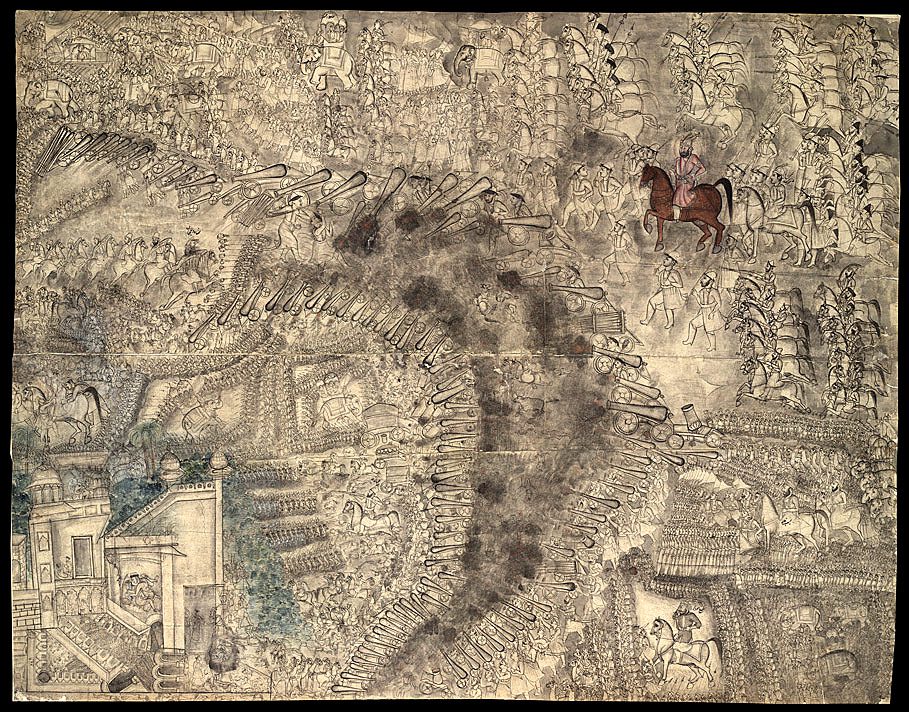
Image of the Third battle of Panipat
Click the link to read >1st Panipat and 2nd Panipat
Three major battles had been fought on the fields of Panipat. The first battle which was fought in the year 1526 resulted in the establishment of the Mughal Empire. The second battle was fought in the year 1556 and ended in the defeat of Hemu. But the third battle of Panipat (1761) was the most terrifying of all and is full of stories of individual bravery, sacrifice, and betrayal.
The Marathas under the leadership of Sadashiv Rao Bahu crossed swords against another invader Ahmad Shah Abdali who belonged to the Durrani clan of Afghanistan.
Content
Background
The great Maratha king, i.e Chhatrapati Shivaji Maharaj, dreamed of establishing an entire Hindu Empire in India by crushing the Mughal rule. When the kingdom after kingdoms were accepting the Mughal authority Veer Chhatrapati Shivaji Maharaj was all alone were fighting to free the country from the clutches of Mughal rule.
The Marathas later in the 18th century were on the verge of achieving the dream of their hero. They had conquered Multan, Lahore, and even Kashmir by the end of 1758-59 under the military command of Raghoba who was sent by Peshwa Balaji Baji Rao. This was perhaps the Indians were dreaming for more than 700 years. By now it was looking like India will achieve their dream of Swaraj.
Rise of the Durrani
Ahmad Shah Abdali was born in 1722 in Multan or maybe in Herat. Initially, he became the general in the army of Nadir Shah the ruler of Persia.
Note: Ahmad Shah Abdali is known as the founder of the modern day Afghanistan.
Nadir Shah recruited Abdali after his conquest of Kandahar. The Persian king soon found a military general in Abdali and later he even regarded him as the most intelligent military ruler in the entire region of Sindh and Persia.

Image of Ahmed Shah Abdali
After the death of Nadir Shah who had a dream of conquering Mughals, Ahmad Shah Abdali assumed the title of the ruler of Afghanistan and Padishah-i-Ghazi (victorious emperor).
Having a dream of crushing the Mughals and capturing the vast wealth of India Abdali in the year 1747 attacked Peshawar and captured it.
Third Battle of Panipat
As mentioned above the Marathas had already captured the northwestern part of India by 1758. Raghunath Rao (Raghoba) pushed back the Afghans (under Taimur and Jahan khan) to the west of Indus. A temporary settlement of the Marathas was established in the Punjab region to check any advance of the Afghans.
At this time the Peshwa i.e. Balaji Baji Rao recalled Raghunath Rao to the south. Due to this move, Abdali got enough time to recapture his lost territories. He destroyed the temporary settlement of the Maratha at Punjab and decided to launch a large-scale invasion of India.
The news of the Abdali’s invasion reached the Peshwa and immediately he appointed Sadashiv Rao Bhau to stop the Durrani’s once and for all. Once again the Indians were ready to stop the advance of the invaders this time at Panipat.

Source: Wikipedia
Under the leadership of Bhau, the Marathas before the battle of Panipat were able to capture Delhi in August 1760. Ambitious Bhau then decided to cut the communication and supply line of the invading army of Abdali which was on the right side of river Yamuna.
Bhau moved further upto Kunjpura (in present day Haryana) for this purpose.
Note: Peshwa Balij Rao also sent his 17 year old son Vishwas Rao in the campaign against the Durrani’s.
But the mobility of the Afghan cavalry failed this move and instead of surrounding the army of Abdali, the Marathas were surrounded by the invaders. The Marathas line of supply and communication was now cut by the Durrani army due to this Bhau decided to entrenched himself in the field of Panipat.
Note: The Marathas apart from their army were also carrying many followers mainly civilians and non-combatants women and children for Pilgrimage.
14 January 1761: Judgement Day
The supply lines of the Marathas were completely cut at the end of November 1760. There was an acute shortage of food and forage for both the army, camp followers and horses. Several military commanders then decided to convince Bhau to enter the battlefield. Hungary and thirsty for several days the Marathas decided to cross swords against the Durrani’s on the day of Makar Sankranti.
Note: The Rohillas gave the provisions to the Afghan army.
The fellow Indian Nawabs and ruler wholeheartedly supported Abdali both militarily and strategically. Some of them were Nawab of Awadh (Shuja ud Daulah) and Rohillas under Najib ud Daulah. It is difficult to believe that when there was a threat to the country our own rulers joined hands with the enemies.
The Marathas deploy their army in the traditional Hindu formation having three divisions’ right, left, and center. The left side was under Ibrahim Gardi an intelligent military commander who had great knowledge in artillery, cannons, and the western style of warfare. The unit of Gardi had about 8000-9000 sepoys armed with firelocks and 40 cannons. Behind them, there was a Maratha cavalry of about 8000 under Damaji Gaekwad, Bithal, and Jaswant Pawar. This cavalry was armed with lances and swords.
The center was under the command of Bhau who was mounted on an elephant along with Vishwas Rao. The right side was under the Sindia’s and the extreme right was under Malhar Rao Holkar.
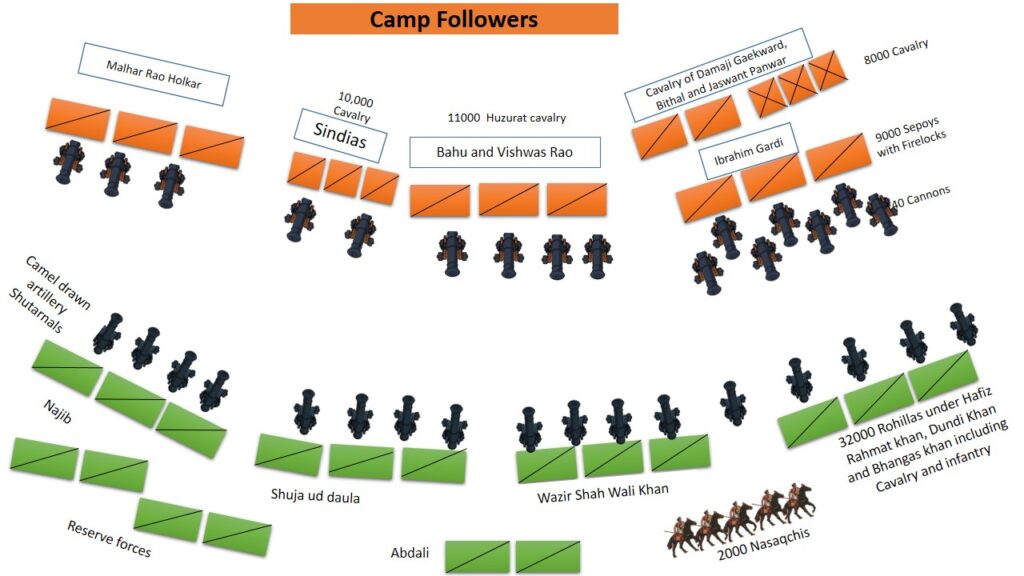
Abdali in green
Ahmad Shah Abdali deployed his army in a crescent shape. The Rohillas under Hafiz Rahmat Khan, Dundi Khan, and Banghas Khan were placed in the extreme right. The center was under Wazir Shah Wali Khan while Shuja and Najib were deployed on the left side.
Abdali had camel-drawn cannon Shutarnals, which played important role in the battle. He placed these cannons in front of his army. Like Mohammed, Ghori deployed a reserve force at the second battle of Tarain in the same way Abdali also deployed a reserve force behind his center unit to protect it from Maratha cavalry.
Carnage
At 9 AM the Marathas left wing which was under Ibrahim Gardi attacked with their heavy artillery on the Rohillas infantry. But the attack didn’t do much damage on the Rohillas and Gardi ordered his firelock sepoys to attack the right flank of Abdali. This time the attack was successful and the right flank of the Rohillas now was in danger. But the cavalry which was behind the Gardi’s men decided to charge on the weakening flank of the Rohillas. The cavalry charge was repulsed by the cannons of the Abdali’s right flank. Both sides suffered a heavy loss during this engagement.
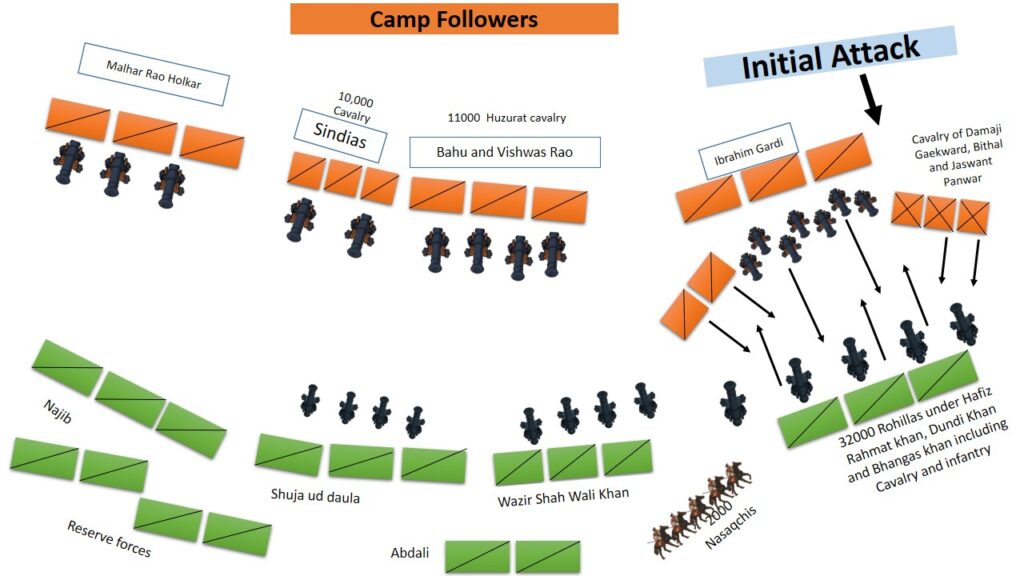
Note: In the above mention attack the cavalry of Damaji Gaekward suffered heavy losses.
At the same time, Bhau decided to launch a cavalry charge on the central wing of the Afghan army. With the chant of Har Har Mahadev, the HUZURAT corps of the Marathas under Bhau and teenage Vishwas Rao charged the fields of Panipat.
The cavalry charge launched by the Marathas was able to break the central wing of the Afghans. Many of the Afghan soldiers retreated due to this. The leader of the central wing i.e Wali Khan appealed to his troop not to leave the battlefield but it had zero effect on the retreating troops.
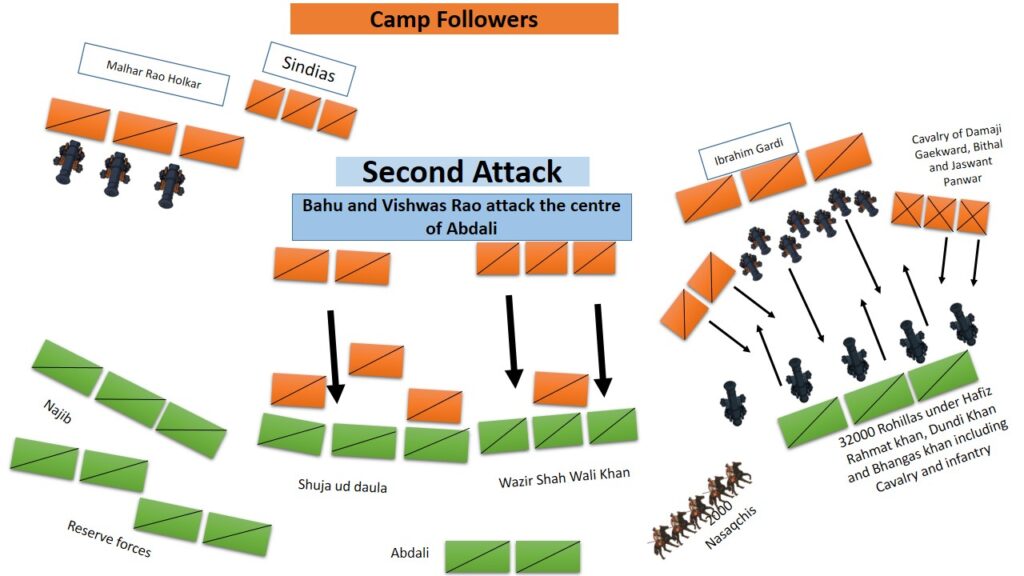
By 12 PM the right and central wings of the Afghans were on the verge of collapse. It was now the responsibility of Abdali to find a quick solution to this.
To handle this situation Abdali ordered his reserved force i.e Nasaqchis to attack both sides of the Marathas. About 2000 Nasaqchis attacked the cavalry of Bhau and Ibrahim Gardi. This moved was the turning point in the battle.
About 1 PM Abdali was able to stabilize the situation and now the Marathas who already suffering from scarcity of food and water now became tired. About 8000 fresh troops attacked Bhau’s unit. The left flank of Abdali also started to attack the Maratha center under Najib. The right and central wings of Marathas lost the communication and now both of them became vulnerable.
Around 2 PM the 17-year-old Vishwas Rao who was fighting courageously got injured by the mobile artillery of Abdali’s central wing. Due to this injury, the teenage warrior soon attained Martyrdom and this lowered the morale of the fellow Maratha soldiers.
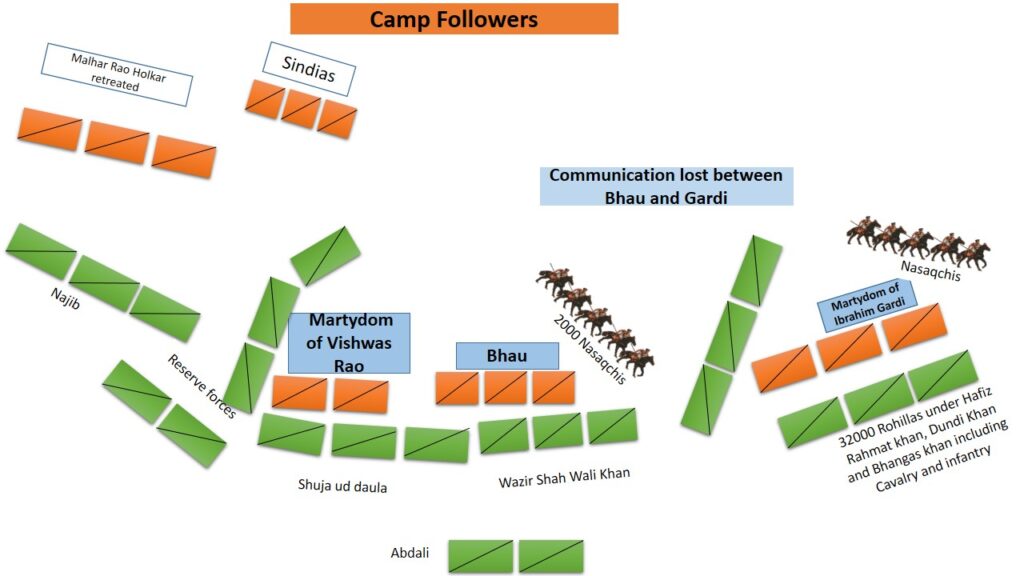
But Bhau decided to fight till his last breath. The troops of Ibrahim Gardi were surrounded by the Rohillas. Around 3.30 PM the right flank of the Maratha was completely disintegrated and its leader i.e. Ibrahim Gardi was captured by the Rohillas.
Now the only hope for the Marathas was Bhau who too was heavily outnumbered. At this critical moment of the battle, the cavalry unit of Malhar Rao Holkar which was in the extreme right of the Marathas decided to retreat from the battlefield.
This further makes way for the Afghans to surround the Maratha center. At last Jankoji Sindia, Bhau, Jaswant Rao Panwar, and some other brave warriors continued fighting.
At last, around 4 PM Bhau and other Maratha attained martyrdom and with them, the battle ended in a decisive victory of the Durrani’s.
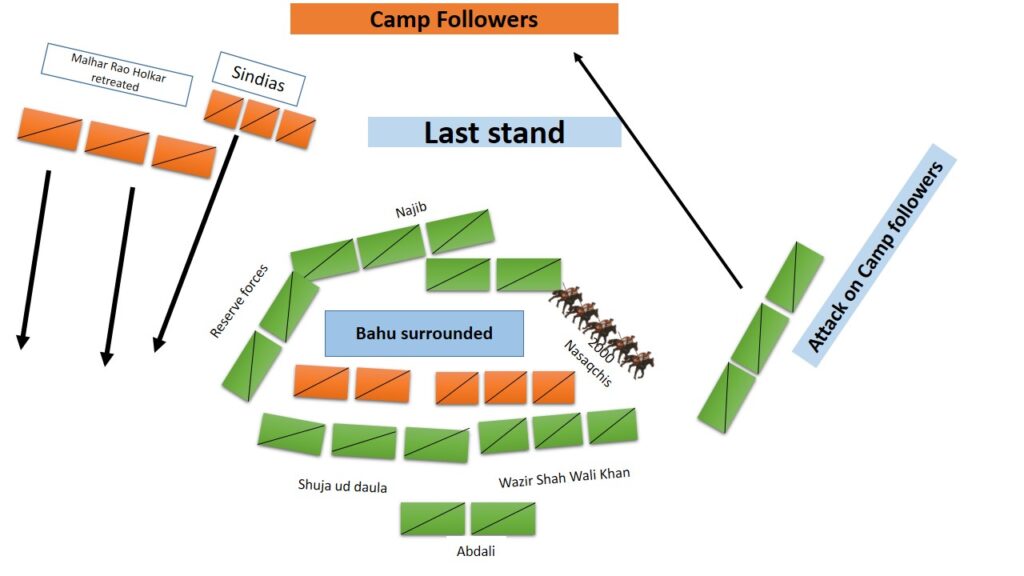
After the battle, the invaders did for what they had been known for i.e. Massacre of innocent women and children. Those women and children who survived this massacre were taken back to Afghanistan and sold in slave markets.
It is believed that the Afghan army also suffered heavy losses. Their number of casualties is about 30000-35000.
Around 40000 Marathas were massacred after the battle of Panipat. Only 10000-11000 Marathas survived to fight for another day. Due to these numbers, the Third battle of Panipat is considered the largest and most eventful fought in the 18th century.
But the names like Sadashiv Rao Bahu and Vishwas Rao who fought with utmost bravery had been forgotten. Indian historians often gave credit to 17-year-old Mohammad bin Qasim for his conquest of Sindh but forgot to mention anything on the martyrdom of men like Vishwas Rao, Bhau, and Ibrahim Gardi.
LIKE WHAT WE ARE DOING? DONATE TO DHARMAYUDH !
If you Support what we are doing and would like to contribute to help us grow and reach more Indians to teach them more about such forgotten historic Indian Heroes and stories, please consider donating any amount. It will help us grow.

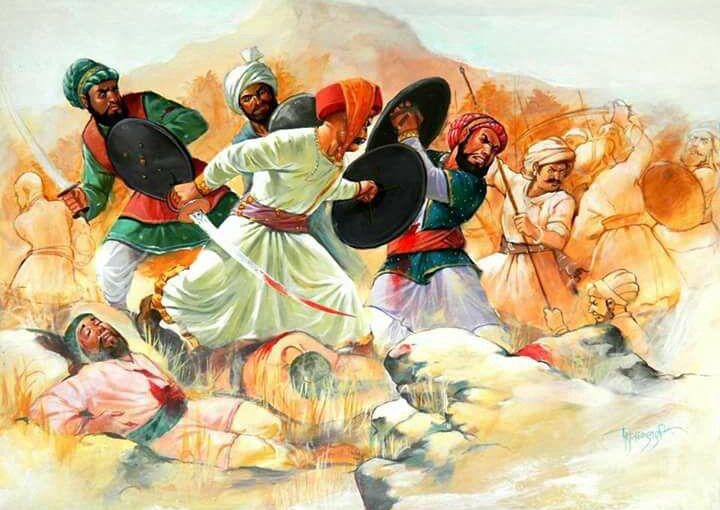
Helpful content makes us proud about our kings and unsung warriors who repulsed the invaders with great and indomitable energy .PLZ also make an article on the battle of BHIMA KOREGAON even a movie is going to be released on it.JAI HIND